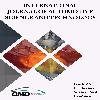Linkage Mechanism Optimization and Sensitivity Analysis of an Automotive Engine Hood
Linkage Mechanism Optimization and Sensitivity Analysis of an Automotive Engine Hood
Equipment such as a rod between vehicle body and hood or a lift strut are used to keep automobile hood in open positions during the regular maintenances or repairs. Moreover, some effort is required to open or close automobile hood because of its weight. To keep it in various opened positions and to exert the least force to open or close it, a mechanism is used in conjunction with extension, compression or torsion springs in two different configurations. Each optimization has been carried out for all these different springs, each in two configurations and results are compared. Sensitivity analysis for the design variables are examined to determine how these variables are influential on the designed mechanism. Optimization results of extension and compression springs are observed to be similar in both configurations of the designed mechanism. On the other hand, results for the torsion spring in two configurations are exactly the same for the mechanism. Sensitivity analysis shows that the designed mechanism is not sensitive on the design variables that are on the bound in both of these two configurations.
Keywords:
Automobile engine hood, Linkage mechanism, Mechanism synthesis, Nonlinear optimization Sensitivity analysis, Springs,
___
- [1] Choi, K.S. et al. (2007). Dynamic analysis of vehicle trunk lid with 4-bar link structure. World Congress, Detroit, Michigan, April 16-19.
- [2] Ko, O.S. (1995). The mechanism analysis on hood, tail gate, and trunk lid by mathematical modeling. International Congress and Exposition, Detroit, Michigan, February 27 – March 2.
- [3] Norton, R.L. (1999). Design of machinery. McGraw-Hill
- [4] Deb, K. and Goyal, M. (1998). Flexible optimization procedure for mechanical component design based on genetic adaptive search. Journal of Mechanical Design 120 (2): 162-164.
- [5] Kannan, B.K. and Kramer, S.N. (1994). An augmented lagrange multiplier based method for mixed integer discrete continuous optimization and its applications to mechanical design. Journal of Mechanical Design 116 (2): 405-411.
- [6] Sandgren, E. (1990). Nonlinear integer and discrete programming in mechanical design optimization. Journal of Mechanical Design 112: 223-229.
- [7] Parades, M. et al. (2001). An optimization process for extension spring design. Computer Methods in Applied Mechanics and Engineering, 191 (8-10): 783-797.
- [8] Nathan, R.H. (1985). A constant force generation mechanism. Journal of Mechanisms, Transmissions and Automation in Design, 107: 508-512.
- [9] Marsh, G.L. (1975). Compression spring. United States: Patent 3,892,398.
- [10] Genova, P.E. (1972). Mechanics of plane mechanisms with spring links. VI Lenin, Sofia, Bulgaria: Mechanical and Electro-Technical Institute.
- [11] Matthew, G.K. and Tezar, D. (1977). Synthesis of spring parameters to balance general forcing functions in planar mechanism. Journal of Engineering for Industry, 347-357.
- [12] Hain, K. (1961). Spring mechanisms point balancing. Spring Design and Application, New York, McGraw-Hill, 268-275.
- [13] Shigley, J.E. et al. (2003). Mechanical engineering design. McGraw, New York, 542.
- [14] Century Springs Company (2003). Torsion springs. Engineers Guide.
- [15] Schwieterman, M.A. and Hutchinson, D.E. (1996). Torsion spring balance assembly and adjustment method. United States: Patent 5,893,936.
- [16] Vrooland, E. J. and Curtis, M. (1985). Spring balance assembly. United States: Patent 4,537,233.
- Yayın Aralığı: Yılda 4 Sayı
- Başlangıç: 2016
- Yayıncı: Otomotiv Mühendisleri Derneği
Sayıdaki Diğer Makaleler
Modelling and Vibration Analysis of Powertrain System
Mehmet Onur Genç, Burak Budak, Necmettin Kaya
Linkage Mechanism Optimization and Sensitivity Analysis of an Automotive Engine Hood
Stress Behavior Improvement Analysis of Automobile Flywheel Experimentally and Numerically
